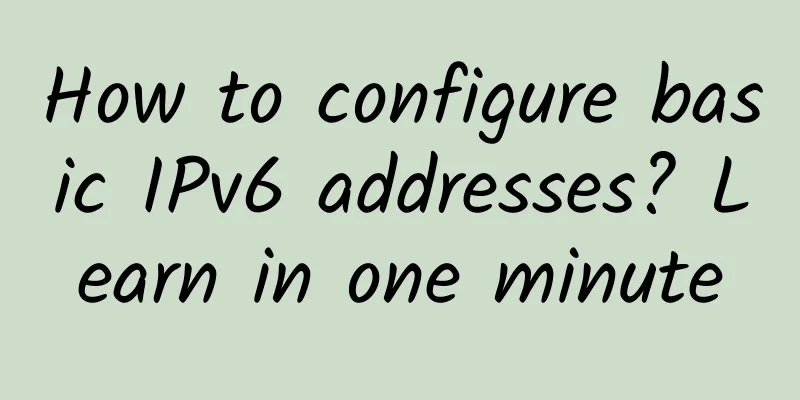How to configure basic IPv6 addresses? Learn in one minute

|
1. Understanding IPv6 IPv6 increases the address length of IPv4 from 32 bits to 128 bits. IPv6 address types: unicast (one-to-one), anycast (one to nearest), multicast (one to many), and there is no concept of broadcast. IPv6 address format: IPv6 address is represented as a series of 16-bit fields, divided into 8 fields, each field is converted into hexadecimal numbers, and the fields are separated by colons. Double colons can be used to represent these consecutive fields with values of 0. This can be done at the beginning, middle, and end of the address, but it can only be used once in each address. IPv6 prefix: used to distinguish networks, such as 2001:1::1/16.
2. IPv6 address classification An IPv6 address is a 128-bit identifier for a single or group of interfaces. In IPv4, IP addresses are divided into five categories: A, B, C, D, and E. IPv6 breaks through the IPv4 category division and is mainly divided into three types of addresses: unicast address, multicast address, and anycast address. The introduction of each type of address is as follows:
3. IPv6 address configuration Configuration on R101:
Configuration on R102:
Testing and viewing of IPv6: Check:
|
>>: Five communication methods between processes required for interviews
Recommend
Better connections enable faster, more flexible networks
For the past two decades, network architectures h...
Sharktech: 1Gbps unlimited traffic high-defense server starting at $49/month, 10Gbps unlimited traffic high-end server starting at $259/month
If you need a high-defense server or an unlimited...
Summary information: Qingyu Internet/Jinpan Cloud/SaltyFishCloud/EasyTan Cloud/TianShang Cloud/Gangan Cloud
I will continue to share some VPS merchant inform...
[Black Friday] FlipperHost: 2GB memory KVM monthly payment starts at $4.9, 4 data centers in Los Angeles and other places
FlipperHost is a foreign hosting company founded ...
The Importance of Ethernet Cabling for High-Speed Internet in Your Home
In today's digital age, having a reliable and...
Virtono adds new Hong Kong data center, 12 data center KVM annual payment starts from 29.95 euros
I received the latest news from Virtono. The merc...
MoonVM: Hong Kong high-bandwidth VPS monthly payment starting from $10.8, 1GB memory/10G SSD/5TB monthly traffic
The tribe once shared information about MoonVM in...
Software-defined revolution: SD-Branch is coming!
Software is taking over the world, and software-d...
The truth about 5G speed, is your 5G package worth it?
[[326825]] We'll cover the different 5G speed...
A detailed explanation of the HTTP protocol
[[393100]] 1. Introduction to HTTP Protocol HTTP ...
LOCVPS 20% off, Japan VPS/Korea VPS/Hong Kong VPS/US VPS monthly payment starts from 29.6 yuan
LOCVPS is a long-established Chinese hosting comp...
Allocating 5G private network spectrum is conducive to promoting market competition
Recently, the delayed 5G spectrum auction in Indi...
Juniper Networks focuses on AI technology to fight the epidemic
With the advent of the "post-epidemic era&qu...
iWebFusion: Los Angeles VPS starting at $9.38 per month, 4GB memory package, upgradeable to 10G bandwidth
iWebFusion (or iWFHosting) is a long-established ...
5G spending of the three major operators decreased, and the number of package users increased
The three major operators recently released their...









